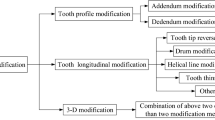Abstract
The “tooth surface distortion” phenomenon is unavoidable when using the additional motion method for helical gear tooth axial modification. To solve this problem, the contact line morphology during helical gear grinding was evaluated by three indicators (the overrun, shift, and offset), and we established a multi-objective contact line optimization mathematical model with the grinding wheel mounting angle as the variable and solved it by a Bayesian regularized BP neural network. The experiments show that the optimized method can lessen the “tooth axial distortion” effects in the process of helical gear tooth axial modification, reduce grinding chatter, and improve grinding efficiency.















Similar content being viewed by others
References
Yoshino H, Ikeno K, Ezoe S (1994) Studies on 3-D tooth-surface modification of helical gears. form grinding of gears with arbitrarily modified tooth traces. Trans Japan Soc Mech Eng Ser C 60:1053–1058. https://doi.org/10.1299/kikaic.60.1053
Litvin FL, Fuentes A (2004) Gear geometry and applied theory. Cambridge University Press
Nishida N, Kobayashi Y, Ougiya Y, Tsukamoto N (1992) A profile calculation method for form grinding wheels. (1st report). grinding wheels for helical gears and avoidance of interferences. J Japan Soc Precis Eng 58:628–634. https://doi.org/10.2493/jjspe.58.628
Yoshino H, Ikeno K (1991) Tooth-trace crowning in form grinding of helical gears. Trans Japan Soc Mech Eng 57:2144–2148. https://doi.org/10.1299/kikaic.57.2144
Nishida N, Kobayashi Y, Ougiya Y, Nagata H (1999) Tooth flank modification processing of helical gears by form grinding method. Trans Japan Soc Mech Eng 65:4458–4463. https://doi.org/10.1299/kikaic.65.4458
Hui Y, Xiaodiao H, Chenggang F, Erkuo G (2019) Analysis and compensation for tooth lead modification with twist error in form grinding. Mach Tool Hydraul 47:106–113, 168. https://doi.org/10.13462/j.cnki.mmtamt.2018.10.016
Shih YP (2010) A novel ease-off flank modification methodology for spiral bevel and hypoid gears. Mech Mach Theory 45:1108–1124. https://doi.org/10.1016/j.mechmachtheory.2010.03.010
Shih YP, Chen SD (2012) A flank correction methodology for a five-axis CNC gear profile grinding machine. Mech Mach Theory 47:31–45. https://doi.org/10.1016/j.mechmachtheory.2011.08.009
Türich A (2010) Producing profile and lead modifications in threaded wheel and profile grinding. Gear Technology 27:54–62
Ozturk S, Kahraman MF (2019) Modeling and optimization of machining parameters during grinding of flat glass using response surface methodology and probabilistic uncertainty analysis based on Monte Carlo simulation. Measurement 145:274–291. https://doi.org/10.1016/j.measurement.2019.05.098
Cao WD, Yan CP, Ding L, Ma YF (2016) A continuous optimization decision making of process parameters in high-speed gear hobbing using IBPNN/DE algorithm. Int J Adv Manuf Technol 85:2657–2667. https://doi.org/10.1007/s00170-015-8114-y
Zhou BC, Wang SL, Fang CG, Sun SL, Dai H (2017) Geometric error modeling and compensation for five-axis CNC gear profile grinding machine tools. Int J Adv Manuf Technol 92:2639–2652. https://doi.org/10.1007/s00170-017-0244-y
Nishida N, Kobayashi Y (1997) Method of working a helical gear by grinding. US
Chinyu W (2002) Studies on the design and form grinding of meshing elements with arbitrary tooth profile. Natl Cheng Kung Univ
Zhejun Y (2014) Gear tool design. Gear Tool Des
Xunru L (1985) Tool design principles and calculations. Tool Des Princ Calculations
Funding
ZW is supported through grants 51875360 from the National Natural Science Foundation of China (NSFC) and 19060502300 from the Shanghai Science and Technology Commission. LL received the support through grant HTL-0-19G04 from the National Key Laboratory of Science and Technology on Helicopter Transmission (Nanjing University of Aeronautics and Astronautics).
Author information
Authors and Affiliations
Corresponding authors
Ethics declarations
Ethics approval
Not applicable.
Consent to participate
Not applicable.
Consent for publication
The manuscript is approved by all the authors for publication.
Competing interests
The authors declare no competing interests.
Additional information
Publisher's note
Springer Nature remains neutral with regard to jurisdictional claims in published maps and institutional affiliations.
Rights and permissions
About this article
Cite this article
Li, Y., Wang, Z., Liu, L. et al. Analysis and optimization of the properties of the grinding contact line for form-grinding modified helical gears. Int J Adv Manuf Technol 120, 403–413 (2022). https://doi.org/10.1007/s00170-022-08778-0
Received:
Accepted:
Published:
Issue Date:
DOI: https://doi.org/10.1007/s00170-022-08778-0



